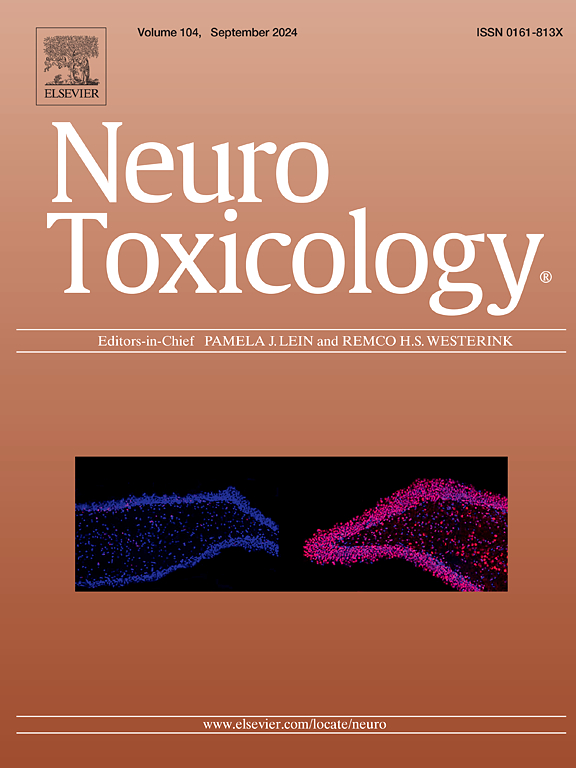Exposure to an environmentally representative mixture of polybrominated diphenyl ethers (PBDEs) alters zebrafish neuromuscular development
IF 3.9
3区 医学
Q2 NEUROSCIENCES
引用次数: 0
Abstract
Polybrominated diphenyl ethers (PBDEs) are a prevalent group of brominated flame retardants (BFRs) added to several products such as electronics, plastics, and textiles to reduce their flammability. They are reported as endocrine disruptors and neurodevelopmental toxicants that can accumulate in human and wildlife tissues, thus making their ability to leach out of products into the environment a great cause for concern. In this study, zebrafish (Danio rerio) embryos and larvae were exposed to a wide concentration range (1.5, 15, 150 and 300 pM) of a PBDE mixture from one to six days post-fertilization (dpf). Hatching rates, mortality and general morphology were assessed during the exposure period. A delay in hatching was observed at the two highest PBDEs concentrations and mortality rate increased at 6 dpf. By 4 dpf, larvae exposed to 150 pM and 300 pM PBDEs developed an upcurved phenotype. Analysis of motor behavior at 6 dpf revealed that PBDE exposure acutely reduced locomotion. To further analyze these motor deficits, we assessed the neural network density and motor neuron and neuromuscular junctions (NMJ) development by immunostaining and imaging. Acetylated α-tubulin staining revealed a significant loss of neurons in a dose-dependent manner. Synaptic vesicle protein 2 (SV2) and ⍺-bungarotoxin (⍺-BTX) staining revealed a similar pattern, with a significant loss of SV2 and nicotinic acetylcholine receptors, thus preventing the colocalization of presynaptic neurons with postsynaptic neurons. Consistent with these results, the presence of cleaved caspase-3 and acridine orange positive cells showed increased cell death in zebrafish larvae exposed to PBDEs. Our results suggest that exposure to PBDEs leads to deficits in the zebrafish neuromuscular system through neuron death, inducing morphological and motor deficiencies throughout their development. They provide valuable insight into the neurotoxic effects of PBDEs, further highlighting the relevance of the zebrafish model in toxicological studies.
接触具有环境代表性的多溴联苯醚混合物会改变斑马鱼的神经肌肉发育
多溴联苯醚(PBDEs)是一组普遍存在的溴化阻燃剂(BFRs),被添加到电子产品、塑料和纺织品等多种产品中,以降低其易燃性。据报道,它们是内分泌干扰物和神经发育毒物,可在人体和野生动物组织中蓄积,因此,它们从产品中渗出进入环境的能力非常令人担忧。在这项研究中,斑马鱼(Danio rerio)的胚胎和幼虫在受精后 1 到 6 天(dpf)期间暴露于浓度范围很广(1.5、15、150 和 300 pM)的多溴联苯醚混合物中。在暴露期间,对孵化率、死亡率和总体形态进行了评估。在多溴联苯醚浓度最高的两种情况下,幼虫的孵化出现延迟,而在受精后 6 dpf 死亡率有所上升。到 4 dpf 时,暴露于 150 pM 和 300 pM 多溴联苯醚的幼虫出现了上弯表型。对 6 dpf 幼虫运动行为的分析表明,暴露于多溴联苯醚的幼虫运动能力会急剧下降。为了进一步分析这些运动缺陷,我们通过免疫染色和成像技术评估了神经网络密度以及运动神经元和神经肌肉接头(NMJ)的发育情况。乙酰化α-微管蛋白染色显示,神经元以剂量依赖的方式显著减少。突触小泡蛋白 2(SV2)和银杏毒素(BTX)染色显示了类似的模式,SV2 和烟碱乙酰胆碱受体显著丢失,从而阻止了突触前神经元与突触后神经元的共定位。与这些结果一致的是,暴露于多溴联苯醚的斑马鱼幼体中出现的裂解的 Caspase-3 和吖啶橙阳性细胞表明细胞死亡增加。我们的研究结果表明,暴露于多溴联苯醚会通过神经元死亡导致斑马鱼神经肌肉系统缺陷,并在其整个发育过程中诱发形态和运动缺陷。这些结果为了解多溴联苯醚的神经毒性效应提供了宝贵的信息,进一步突出了斑马鱼模型在毒理学研究中的相关性。
本文章由计算机程序翻译,如有差异,请以英文原文为准。
求助全文
约1分钟内获得全文
求助全文
来源期刊

Neurotoxicology
医学-毒理学
CiteScore
6.80
自引率
5.90%
发文量
161
审稿时长
70 days
期刊介绍:
NeuroToxicology specializes in publishing the best peer-reviewed original research papers dealing with the effects of toxic substances on the nervous system of humans and experimental animals of all ages. The Journal emphasizes papers dealing with the neurotoxic effects of environmentally significant chemical hazards, manufactured drugs and naturally occurring compounds.
 求助内容:
求助内容: 应助结果提醒方式:
应助结果提醒方式:


